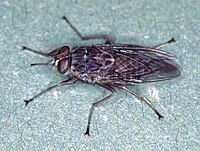
Epizootiology and Molecular Identification of Trypanosome Species in Livestock Ruminants in the Gambia.
Sign Up to like & getrecommendations! Published in 2021 at "Acta parasitologica"
DOI: 10.1007/s11686-021-00442-z
Abstract: INTRODUCTION African Animal Trypanosomiasis (AAT) or nagana in animals, is caused by the blood-borne parasitic protozoa called trypanosomes, and is potentially fatal. It is estimated that Africa loses $4‒5 billion annually due to the death… read more here.
Keywords: molecular identification; trypanosome species; gambia; congolense ... See more keywords

Hybridization in Trypanosoma congolense does not challenge the predominant clonal evolution model. A comment on Tihon et al., 2017, Mol. Ecol.
Sign Up to like & getrecommendations! Published in 2018 at "Molecular Ecology"
DOI: 10.1111/mec.14714
Abstract: Tihon et al. have just published in Mol. Ecol. a fine genomic study on Trypanosoma congolense, agent of Animal African Trypanosomiasis. They present very convincing evidence that T. congolense underwent several hybridization events between distinct… read more here.
Keywords: clonal evolution; trypanosoma congolense; congolense; predominant clonal ... See more keywords

In vivo effect of Commiphora swynnertonii ethanolic extracts on Trypanosoma congolense and selected immunological components in mice
Sign Up to like & getrecommendations! Published in 2017 at "BMC Complementary and Alternative Medicine"
DOI: 10.1186/s12906-017-1785-1
Abstract: BackgroundThe search for alternative trypanocidal compounds which can be available at affordable price is of paramount importance for control of trypanosomosis in human and animals. The current study evaluates the in vivo activity of ethanolic… read more here.
Keywords: selected immunological; trypanosoma congolense; congolense; immunological components ... See more keywords

Molecular characterization of tsetse’s proboscis and its response to Trypanosoma congolense infection
Sign Up to like & getrecommendations! Published in 2017 at "PLoS Neglected Tropical Diseases"
DOI: 10.1371/journal.pntd.0006057
Abstract: Tsetse flies (Glossina spp.) transmit parasitic African trypanosomes (Trypanosoma spp.), including Trypanosoma congolense, which causes animal African trypanosomiasis (AAT). AAT detrimentally affects agricultural activities in sub-Saharan Africa and has negative impacts on the livelihood and… read more here.
Keywords: congolense infection; trypanosoma congolense; congolense; infection ... See more keywords

Cooperativity of catalytic and lectin-like domain of Trypanosoma congolense trans-sialidase modulates its catalytic activity
Sign Up to like & getrecommendations! Published in 2022 at "PLoS Neglected Tropical Diseases"
DOI: 10.1371/journal.pntd.0009585
Abstract: Trans-sialidases (TS) represent a multi-gene family of unusual enzymes, which catalyse the transfer of terminal sialic acids (Sia) from sialoglycoconjugates to terminal galactose or N-acetylgalactosamine residues of oligosaccharides without the requirement of CMP-Neu5Ac, the activated… read more here.
Keywords: lectin like; transfer; tconts1a; domain ... See more keywords

Life cycle adapted upstream open reading frames (uORFs) in Trypanosoma congolense: A post-transcriptional approach to accurate gene regulation
Sign Up to like & getrecommendations! Published in 2018 at "PLoS ONE"
DOI: 10.1371/journal.pone.0201461
Abstract: The presented work explores the regulatory influence of upstream open reading frames (uORFs) on gene expression in Trypanosoma congolense. More than 31,000 uORFs in total were identified and characterized here. We found evidence for the… read more here.
Keywords: congolense; reading frames; upstream open; gene ... See more keywords

Cloning and Characterization of Trypanosoma congolense and T. vivax Nucleoside Transporters Reveal the Potential of P1-Type Carriers for the Discovery of Broad-Spectrum Nucleoside-Based Therapeutics against Animal African Trypanosomiasis
Sign Up to like & getrecommendations! Published in 2023 at "International Journal of Molecular Sciences"
DOI: 10.3390/ijms24043144
Abstract: African Animal Trypanosomiasis (AAT), caused predominantly by Trypanosoma brucei brucei, T. vivax and T. congolense, is a fatal livestock disease throughout Sub-Saharan Africa. Treatment options are very limited and threatened by resistance. Tubercidin (7-deazaadenosine) analogs… read more here.
Keywords: vivax; nucleoside transporters; trypanosomiasis; congolense ... See more keywords

Phloroglucinol as a Potential Candidate against Trypanosoma congolense Infection: Insights from In Vivo, In Vitro, Molecular Docking and Molecular Dynamic Simulation Analyses
Sign Up to like & getrecommendations! Published in 2022 at "Molecules"
DOI: 10.3390/molecules27020469
Abstract: Sub-Saharan Africa is profoundly challenged with African Animal Trypanosomiasis and the available trypanocides are faced with drawbacks, necessitating the search for novel agents. Herein, the chemotherapeutic potential of phloroglucinol on T. congolense infection and its… read more here.
Keywords: molecular docking; phloroglucinol complex; congolense; sialidase ... See more keywords

The Activity of Red Nigerian Propolis and Some of Its Components against Trypanosoma brucei and Trypanosoma congolense
Sign Up to like & getrecommendations! Published in 2023 at "Molecules"
DOI: 10.3390/molecules28020622
Abstract: Propolis is a resin that is gathered by bees from exudates produced by various plants. Its exact chemical composition depends on the plants available near the hive. Bees use propolis to coat the surfaces of… read more here.
Keywords: trypanosoma brucei; brucei congolense; red nigerian; nigerian propolis ... See more keywords